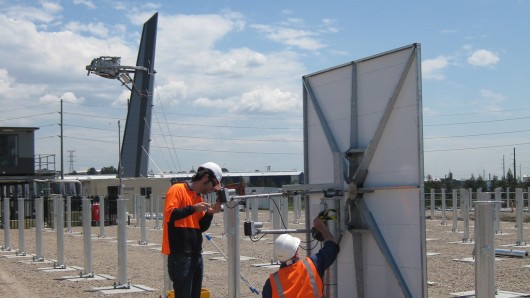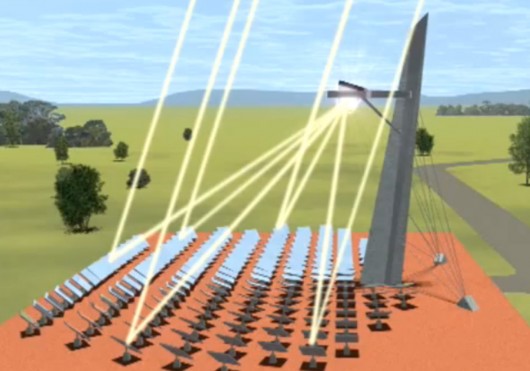New solar thermal tower power plant being built that requires only sun and air
By Darren Quick
19:04 October 26, 2010
Although electrical devices have evolved rapidly over the last few decades, the plants used to generate the electricity that power these devices are still dominated by the use of steam turbines that convert thermal energy, usually from the burning of fossil fuels, into mechanical energy. Even newer solar thermal power plants concentrate the sun’s rays to heat water into high-pressure steam to drive a turbine. But with water not always readily available in locations suited to harnessing solar energy, such as deserts, a new type of solar thermal field, tower and research facility is being built in Australia that requires only air and the sun, making it ideal for parts of the world that receive minimal rainfall.
The technology, developed by Australia’s national science agency the Commonwealth Scientific and Industrial Research Organisation (CSIRO), functions in much the same way as a conventional solar power tower plant. It focuses the sun’s rays with a field of mirrors known as heliostats onto a 30-meter (98 ft) high solar tower. But instead of heating water into steam to power a turbine, the solar Brayton Cycle system uses the concentrated solar energy to heat compressed air, which expands through a 200kW turbine to generate electricity. To overcome sun variability the compressed air can also be heated by natural gas combustion.
This week the CSIRO began installing 450 large heliostats at the agency’s National Solar Energy Centre (NSEC) in Newcastle, New South Wales. Once installed, the heliostats will form Australia’s largest solar-thermal tower system and will concentrate the sun’s rays to create temperatures of up to 1,000 degrees Celsius (1,832 F). The heliostats, manufactured by Performance Engineering Group, are smaller than many heliostats currently being used around the world and consist of a lightweight steel frame with a simple design specially created for mass production for the commercial market to make solar fields more cost effective to build and operate.
The CSIRO says the aim of developing the technology was to make solar generated electricity at the same cost or cheaper than fossil fuel generated electricity when the cost of carbon is taken into account.
The solar Brayton Cycle project will also incorporate the option of a future solar thermal storage system that would allow extended operation during peak demand times and address the challenge of continuous operation from renewable energy sources.
Once completed the solar Brayton Cycle field will be the largest of its type in the world, covering an area of 4,000 square meters (43,055 square feet). The field will be used to refine the technology in order to make it a cheaper, more efficient energy source suitable for many desert locations in Australia and around the world. Although the facility will be used for researching solar technology, the CSIRO says a field of this size could generate enough electricity to power nearly 100 homes.
Copyright © gizmag 2003 - 2010 To subscribe or visit go to: http://www.gizmag.com

